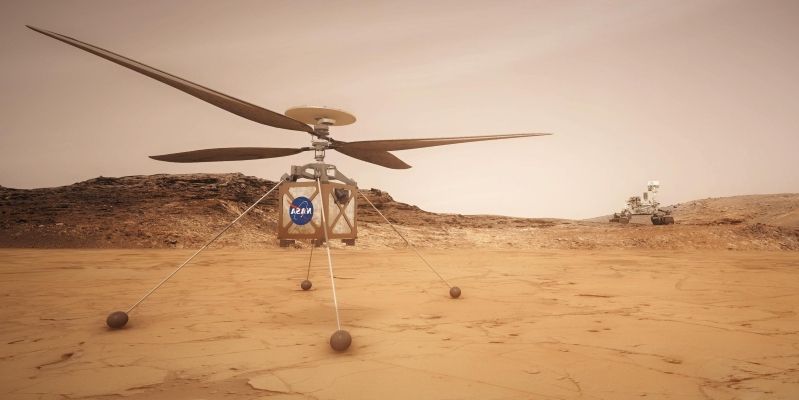Mars Helicopter is Ready for Extraterrestrial Flight
Listen to “E221 Mars Helicopter is Ready for Extraterrestrial Flight” on Spreaker.
Article by NASA January 4, 2020 (lakeconews.com)
• When NASA’s next Mars rover sets out for the Red Planet in 2020, it will bring along a Mars Helicopter. It is touted as another “first” for Mars. NASA wants to expand its exploration capabilities to include an aerial dimension, new areas for exploration, faster reconnaissance, and access to terrain not reachable by rovers or astronauts.
• The Mars Helicopter’s unique design is driven by the harsh realities of Mars’ environment. The Martian atmosphere is extremely thin and cold, with only 1 to 2 percent the density of sea-level air. With temperatures down to -130˚ F it resembles Earth’s atmosphere at 100,000 feet – an altitude far beyond the capabilities of regular helicopters.
• Researchers at NASA’s Jet Propulsion Laboratory, NASA Ames Research Center, NASA Langley Research Center and AeroVironment Inc., worked together over several years to develop a viable vehicle design that is part aircraft and part spacecraft. A crucial aspect of the design is to keep the mass as low as possible, but to carry enough power and energy to sustain the helicopter during flight. With two four-foot rotors that spin in opposite directions at approximately 2500 revolutions per minute, the Mars Helicopter weighs only four lbs.
• The Mars Helicopter is designed to operate at a height of 16 feet for only about 90 seconds at a time. Between flights, the helicopter recharges its batteries with an onboard solar panel. The helicopter navigates utilizing a vision-based navigation system, unassisted by humans, GPS or other navigation aids. A 12-megapixel camera takes pictures during flight, which are beamed back to the rover for relay to Earth. During the cold Martian nights, the batteries and sensitive electronics are kept warm inside a heated and insulated fuselage.
• The research team replicated the conditions of the Martian atmosphere in a 25-foot vacuum chamber ‘Space Simulator’ complete with emulated Martian winds. The team performed extensive modeling and simulation, as well as low-density experiments to determine how the helicopter would respond to the thin atmosphere, wind gusts, temperature and radiation. Controlled flight of a test vehicle was achieved in May 2016. The actual Mars Helicopter Flight Model which will be sent to Mars performed its maiden hover flight in early 2019. It will now be integrated with the rover with its next flight over the Red Planet.
• [Editor’s Note] Once again, NASA is depicting the Martian atmosphere as extremely thin, cold and inhospitable. But we know from Mars insiders such as Andrew Basiago, Randy Cramer, Tony Rodrigues, and Corey Goode that the Martian air is breathable. The air isn’t as thin as NASA claims. The planet is cold primarily at the poles, and electric storms pervade the equatorial region.
NASA wants to appear as if it is exploring the surface of Mars without really exploring it, because they don’t want to reveal the extensive presence already on the planet by secret space programs and indigenous beings, mostly underground. But not to worry. This Mars Helicopter only travels in 90-second spurts, 16 feet off of the ground before needing to recharge. How much ‘exploring’ can it accomplish?
The Mars Helicopter is a technology demonstration for the Mars 2020 rover mission, intended to show the feasibility and utility of using helicopters for Mars exploration.
This technology may enable future missions to perform reconnaissance or independent science, and to access terrain not reachable by rovers and astronauts.
When NASA’s next Mars rover sets out for the Red Planet in 2020, it will bring along a passenger. Nestled under the belly of the rover, the Mars Helicopter will be on a mission to notch a “first” for humankind: flying a helicopter on another planet.
By sending the helicopter to Mars as a technology demonstration, NASA aims to expand its exploration capabilities to include an aerial dimension, potentially opening new areas to exploration, and enabling faster reconnaissance for the benefit of future rovers or astronauts.
With a four-foot rotor and a weight of only four lbs, the Mars Helicopter’s unique design is driven by the harsh realities of the Mars environment.
The Martian atmosphere is extremely thin and cold; at only 1 to 2 percent, the density of sea-level air and with temperatures down to -130˚ F, it resembles Earth’s atmosphere at 100,000 feet – an altitude far beyond the capabilities of regular helicopters.
To make the Mars Helicopter a reality, researchers from NASA’s Jet Propulsion Laboratory, NASA Ames Research Center, NASA Langley Research Center and AeroVironment Inc., worked together over several years to understand the unique challenges of flying on Mars, and to develop a viable vehicle design that is part aircraft and part spacecraft.
A crucial aspect of the design is to keep the mass as low as possible, but to carry enough power and energy to sustain the helicopter during flight. Recent technological advances in areas such as batteries and solar cells, miniaturized sensors and computers, and lightweight materials are key to achieving this goal.
Many components of the Mars Helicopter were developed for the commercial cell phone and drone markets. They were qualified for the Mars Helicopter mission through testing in Mars-like temperatures and by subjecting them to radiation levels that would be experienced in space.
The Mars Helicopter is designed to operate independently on Mars, performing flights of about 90 s in duration at a height of 16 feet. The two rotors spin in opposite directions at approximately 2500 revolutions per minute.
1:22 minute Mars Helicopter demonstration (‘NASA Jet Propulsion Laboratory’ YouTube)
FAIR USE NOTICE: This page contains copyrighted material the use of which has not been specifically authorized by the copyright owner. ExoNews.org distributes this material for the purpose of news reporting, educational research, comment and criticism, constituting Fair Use under 17 U.S.C § 107. Please contact the Editor at ExoNews with any copyright issue.
